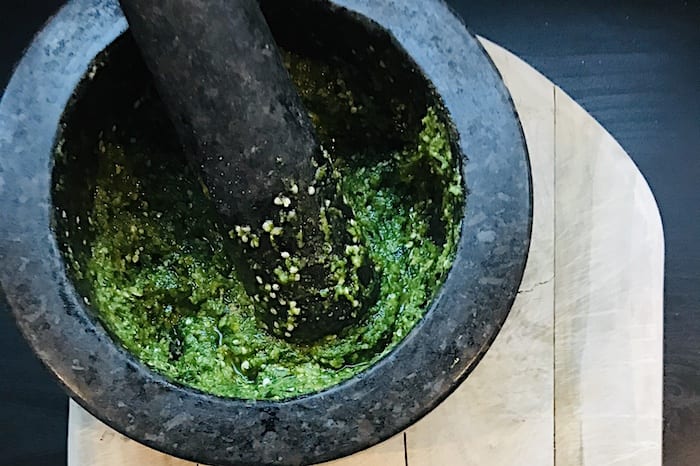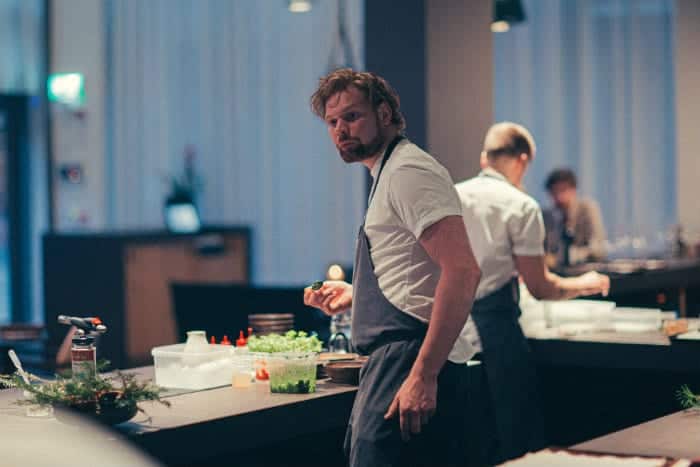ManchesterChef: British summer pesto recipe by Simon Martin
- Written by Louise Rhind-Tutt
- Last updated 4 years ago
- Uncategorized

We were all thrilled to see Mana in Ancoats win a Michelin star last October – the first in Manchester city centre in over four decades.
The game-changing restaurant was named one of the top 100 in the UK last year, as well as getting rave reviews from Grace Dent in The Guardian and Marina O’Loughlin in The Sunday Times – the latter declaring: “This isn’t a good restaurant by Manchester standards; this is a good restaurant by world standards.”
Chef-patron Simon Martin has wowed us with his creative cookery using the best produce found in the British Isles. And now, he’s shared his own recipe for a modern British take on pesto with I Love MCR – it’s perfect in pasta salads or simply on good bread.

“Here’s a recipe for a paste which very closely resembles a pesto, although instead of ingredients like olive oil and black pepper, we use British ingredients which might not bring back memories of a warm summer’s evening eating bruschetta on the Amalfi Coast, but does provide a distinct sense of time and place,” says Simon.
“One of the aspects of cooking I enjoy the most is translating terroir, so taking something as common as pesto and transforming it into the epitome of modern British cooking, resulting in what I believe to be a better end product, is massively rewarding and affirmative that I have a great reason to practise the ethos of celebrating our island’s produce.
“Many of our greatest successes with the menu at Mana have been born from taking something well-known and humble, then reimagining it by applying our technique and produce, whilst being consciously aware of and respecting the source material to retain its identity and soul.
“This ‘pesto’ is also nut free, simply because I once ate a raw pine nut and it made everything taste metallic for a week so it put me off. But you could add a roasted walnut puree (Google is your friend) if you were so inclined.”

Ingredients:
- 20g picked flat leaf parsley
- 20g elderflowers (pick them on a warm day and use them immediately)
- 20g picked lemon thyme
- 10g wild garlic capers
- 5g Alexander seeds
- 6 tablespoons cold-pressed hemp oil
- 20g Doddington cheese – frozen and then Microplaned
- 3g Halen Mon salt
- Juice of 3 large green tomatoes
You will also need:
A microplane, the finer the better
Method:
- “Firstly, get everybody in your household picking the herbs, flowers and capers by separating them from their stems. It’s a labour intensive process but the faster and better you do it, the better the result will be as they are the life and energy in this recipe which everything else is simply there to support.
- “At the restaurant, we work with almost everything over crushed ice because we want to keep temperatures down and freshness at its peak before applying that ultimate human interaction, whether that be heating, grinding, blending or freezing, you need your produce to be at its peak before you intervene.
- “Juice your tomatoes. If you do not have a juicer, chop or blend them, then squeeze through a fine sieve or muslin cloth. Put your tomato juice in a small saucepan and reduce by 2/3. The reduction intensifies the flavour and acidity and evaporates liquid matter, enabling us to keep the end product as a paste, as opposed to a sauce.
- “At Mana, we use a dehydrator for reductions because reducing something slowly retains purity and clarity, so if you have a dehydrator or a spare oven you can keep on 60°C for a day, use that instead, but be aware of the pre-preparation you’ll need to do for this.
- “Next comes the pestle and mortar. The reason we use this as opposed to a blender is because blenders cut, they don’t crush, and crushing is what we need to extract flavour by forcing certain chemical reactions. This is most notable in ingredients belonging to the allium family (garlic, onions, leeks) where crushing as opposed to cutting produces a compound called allicin. This technique also applies to herbs and brassica like wasabi.
- “We don’t always want this effect, for example many top kitchens require you to have an extra-sharp knife just for cutting chives, because they’re commonly used for their mild flavour and using a blunt knife would crush the chives producing too much of that allium flavour. In this case though, pesto is bold, rustic and powerful, so we want to remain true to those characteristics.
- “First, we grind the dry ingredients. Add the salt and Alexander seeds to the mortar (the bowl) and begin grinding in a circular motion with the pestle. You can hit it a few times first to get the process started, just warn your companions first.
- “When the dry ingredients are coarsely ground you can add the capers. It’s important that these are ground in a dry environment surrounded by additional coarse material because this is your allium and we need as much friction as possible to bring out that allicin, which serves as the spice in this preparation, because spice is the sixth flavour profile (on top of the other five profiles: sweet, sour, bitter, salt and umami).
- “Next, we can add the herbs and elderflowers. Grind quickly and as finely as possible (usually when you cannot feel your arms anymore). The more we grind, the better the flavour.
- “Now we have the more pleasurable part. Add the hemp oil and cheese and fold them in with a spoonula (silicone spatula with a rounded head). Taste it now, so you can see the difference when we add acid.
- “Finally, we’ll add the reduced tomato juice. This is an important step and the acidity of your tomatoes will greatly affect the outcome, hopefully you’ll have the means to make the reduction in an oven or dehydrator to produce a cleaner flavour. You will want to add this reduction slowly, continually tasting, until the acidity simply enhances the flavour of the herbs – this is not a condiment and acidity should not be the first thing you experience when tasting.
- “Now, you have British pesto. Use it on cold pasta, bread, anything really – it’s delicious.”
Simon’s tips on where to buy the ingredients:
Alexander seeds, ramson capers, elderflower: Bello Wild Food
Parsley and thyme: anywhere selling British, but preferably living in a pot
Doddington Cheese: Cartmel Cheese
Halen Mon Salt: Halen Mon
Hemp Oil: Amazon or, if you’re in Manchester, Unicorn Grocery
Tomatoes: Banks tomatoes, Southport. Best tomatoes in Europe in my opinion.
- This article was last updated 4 years ago.
- It was first published on 1 June 2020 and is subject to be updated from time to time. Please refresh or return to see the latest version.
Did we miss something? Let us know: [email protected]
Want to be the first to receive all the latest news stories, what’s on and events from the heart of Manchester? Sign up here.
Manchester is a successful city, but many people suffer. I Love Manchester helps raise awareness and funds to help improve the lives and prospects of people across Greater Manchester – and we can’t do it without your help. So please support us with what you can so we can continue to spread the love. Thank you in advance!
An email you’ll love. Subscribe to our newsletter to get the latest news stories delivered direct to your inbox.
Got a story worth sharing?
What’s the story? We are all ears when it comes to positive news and inspiring stories. You can send story ideas to [email protected]
While we can’t guarantee to publish everything, we will always consider any enquiry or idea that promotes:
- Independent new openings
- Human interest
- Not-for-profit organisations
- Community Interest Companies (CiCs) and projects
- Charities and charitable initiatives
- Affordability and offers saving people over 20%
For anything else, don’t hesitate to get in touch with us about advertorials (from £350+VAT) and advertising opportunities: [email protected]


Gyms are failing deaf people – but this company is planning to fix it

The world-renowned Mancunian architect behind Old Trafford’s future

Manchester United reveal plans for new 100,000-seater stadium – set to be UK’s biggest

Review: RNCM Session Orchestra with Tim Burgess and Helen O’Hara is ‘a joyful evening of classics’
















